Must Reads: Friends took this photo at their favorite bar in Thousand Oaks. Minutes later, the shooting started
They grin as they drape their arms around one another.
Telemachus Orfanos and Brendan Kelly lift their beers in a toast. A tattoo memorializing the Las Vegas mass shooting — which both men survived — is visible underneath Kelly’s shirt.
In front of them, Justin Meek and Garrett Gratland prop up a friend who is crouched off-balance, a finger pressed mischievously to his pursed lips. An American flag is displayed behind the 11 friends, who lean close together.
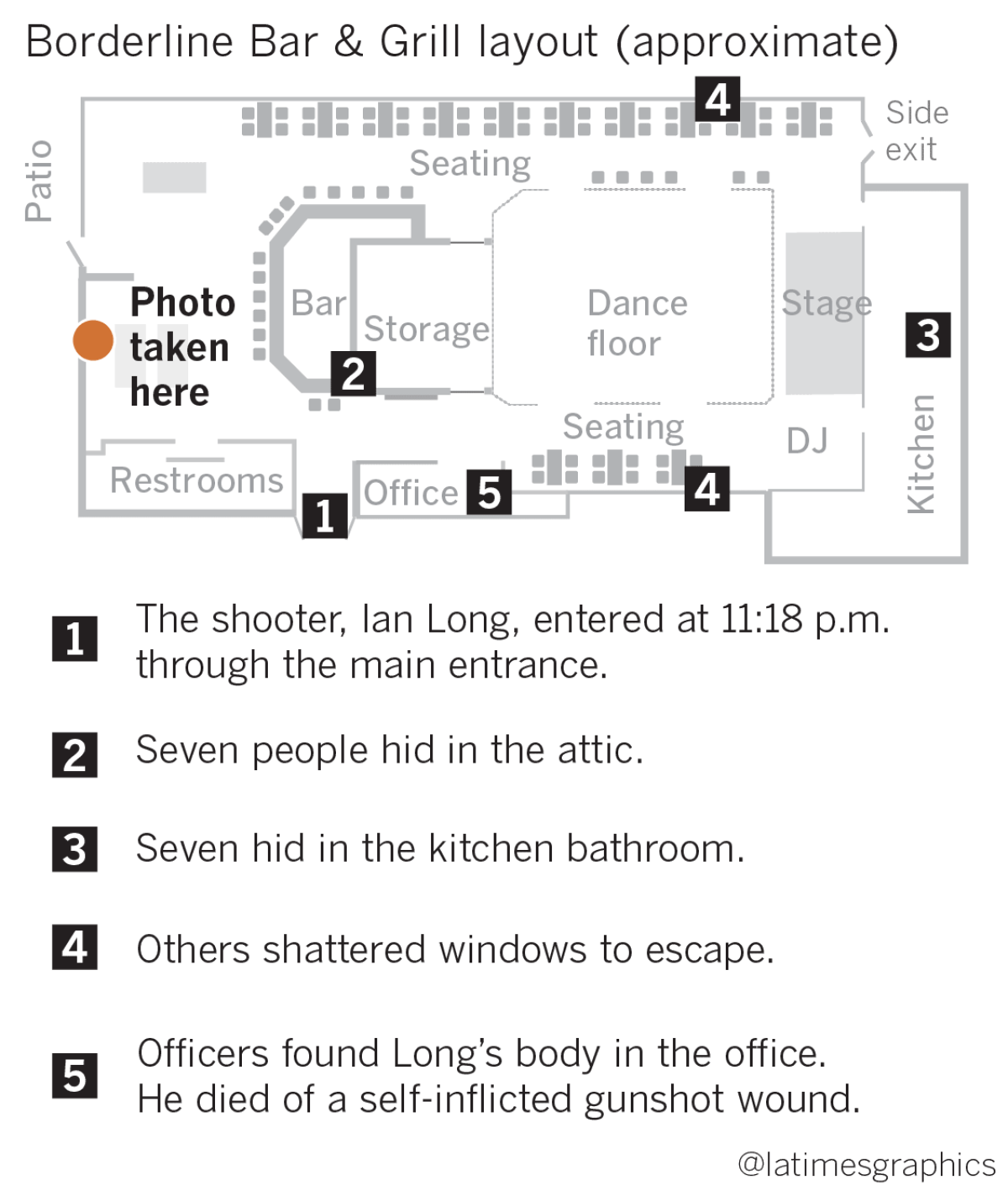
The photo was taken around 11 p.m. Nov. 7, minutes before a stranger walked into Borderline Bar and Grill, spraying bullets as people ducked for cover and fled in terror.
By the end of the night, 12 people had been killed, making the mass shooting one of the deadliest in American history.
Two of the friends in the photo did not make it out alive.
Some chose to stay in the bar so they could help others hide and escape or shield them from gunfire. The bar was popular with veterans and cops, many of whom put their training saving lives to use that night.
Witnesses’ accounts from the Thousand Oaks massacre paint a portrait of heroism that often goes unrecognized in mass shootings. Most of the people who died that night did so while trying to save others, according to interviews and public statements from more than 75 survivors, law enforcement officials and victims’ family members. Their bravery saved lives, officials say.
At funerals for those killed, pastors have repeated a telling refrain: There is no greater act of love than to lay down your life for a friend.
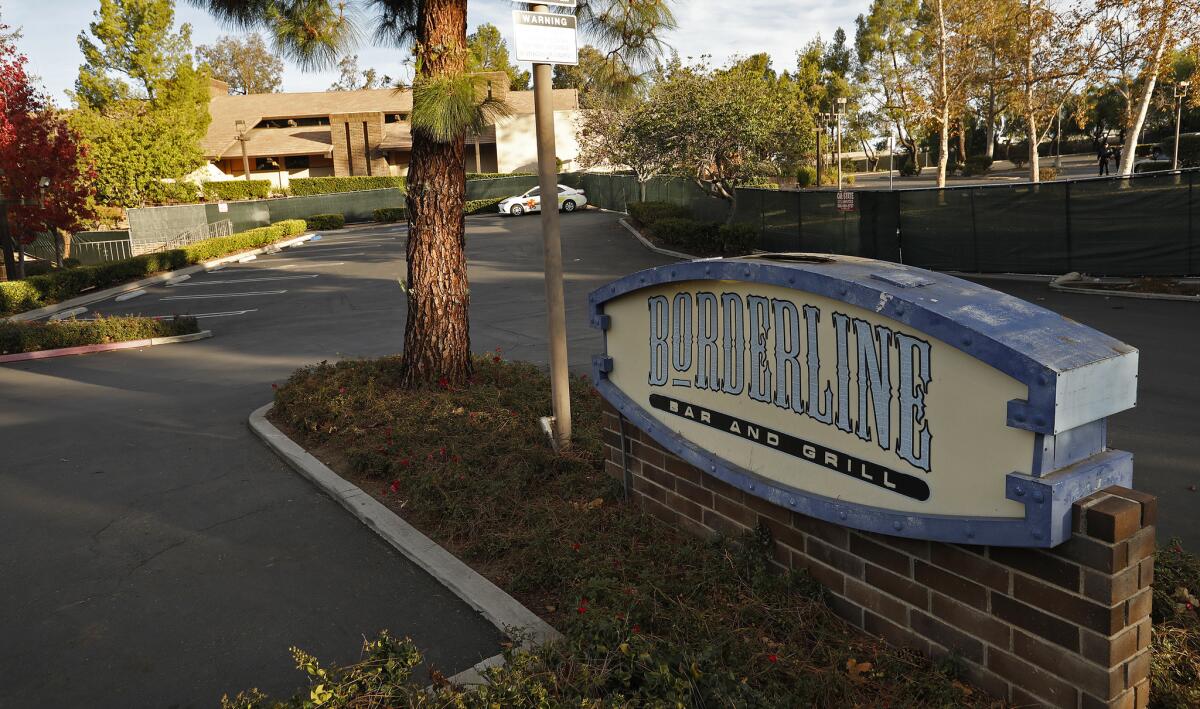
The country-themed Borderline is an unlikely institution in Thousand Oaks, a family-friendly suburb 40 miles northwest of Los Angeles.
Nestled away from the main road, Borderline resembles a large cabin with glass windows and wood-paneled walls. On Nov. 7, about 175 people were inside, including college students celebrating 18th, 20th and 21st birthdays. The dance floor, where people twirl and click their cowboy boots in unison, was mostly empty.
Around 9:30 p.m., Orfanos, who worked as a Borderline security guard, sipped an extra-large beer. A friend swung open the bar’s saloon doors and asked him if he was working.
“Do you think I’m working?” Orfanos said, smirking.
Orfanos, 27, had the night off. But after the October 2017 mass shooting in Las Vegas, Borderline had become a sanctuary for him and other survivors — a place to hear country music and feel safe. Orfanos, who served two and a half years in the Navy, had helped pack wounds for those injured at the Route 91 Harvest country music festival.
Over the next hour, more of Orfanos’ friends showed up. Borderline regulars recognized him, the life of the party with a warm smile. He was unusually kind; he would give drunk people rides home at the end of the night to make sure they got there safe.

Orfanos and 10 friends gathered for a photograph near the pool tables. The photo was taken with the cellphone of Justin Meek, 23, who worked as a security guard and a promoter, encouraging people to spend their evenings at Borderline. Meek, a lifelong country music fan and gifted singer, had just finished running the 9 p.m. promoters meeting, at which they planned for the bar’s Christmas party.
Meek’s younger sister was at the bar that night too, also working as a promoter. They were three years apart but liked to tell people they were fraternal twins.
“I’m going to check on my sister,” Meek told his friends. “I’ll be right back.”
Kelly, a 22-year-old Marine, drank a shot at the bar. He’d been lauded after the Vegas shooting for protecting a woman he had made friends with two hours before the blasts began. Kelly, a quadruplet who grew up in Thousand Oaks, could quickly befriend anyone, his crew would tell you.
Kelly heard the thumping of bass as “Turn Up the Music” by Chris Brown began to play over the speakers. He headed to the dance floor.
Gratland, 24, stayed back. He had been going to Borderline for six years but had never gotten the hang of line dancing. Instead, he ordered a grilled cheese and a beer.
He was headed overseas for a job in private security in a few days. He had recently left the Army after six years of service.
Once his sandwich arrived, Gratland tucked half of it into his shirt pocket as a joke. He was the group’s goofball.
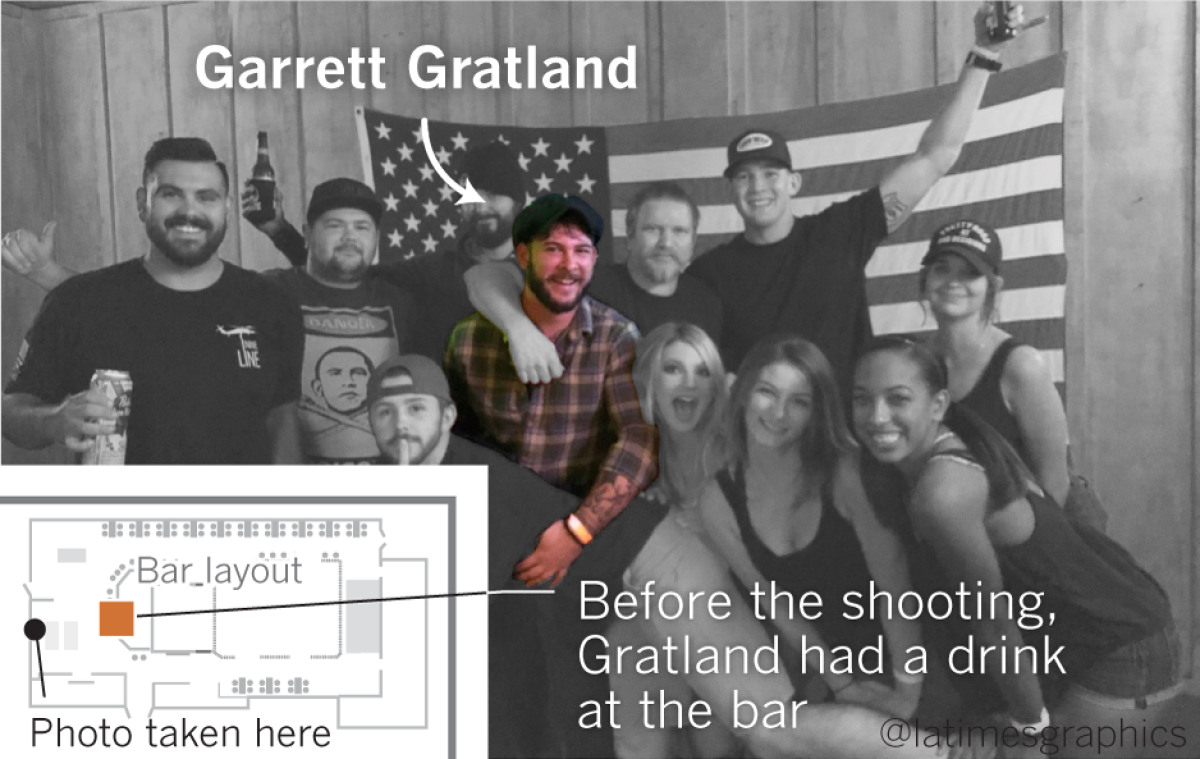
“I’ll keep this safe from you guys,” Gratland said playfully, his handlebar mustache rising up with each word.
The gag was captured in a video timestamped 11:16 p.m., two minutes before the shooter entered the bar.
Stepping out of his car in the Borderline parking lot, Ian Long felt the sting of the chilly autumn night. He saw the glow of lights from the bar and silhouettes moving on the other side of the glass.
Long, 28, had grown up in Thousand Oaks and had been to Borderline. Wednesday was “college night,” an 18-and-over event advertised to universities across the region, including the one nearby he had attended.
At 11:18 p.m., Long stalked through Borderline’s front door wearing a black sweatshirt and a beanie. Armed with a .45-caliber Glock handgun, a folding knife and seven high-capacity magazines, he turned to his right and killed the young woman at the cash register.
He aimed his weapon at customers and kept firing. He was a veteran of the war in Afghanistan, trained as a machine-gunner.
Patrons dropped to the floor or frantically tried to hide. Some called 911. Long fired at people who were lying down.
The dance floor
Katie Wilkie, 24, assumed her favorite spot, near the front of the dance floor by the emergency exit. The dance was about halfway through when she heard gunshots and turned her head. Long had started firing and was headed toward them.
“I saw a handgun face everyone on the dance floor,” she said.
Patrons dropped to the floor or frantically tried to hide. Some called 911. Long fired at people who were lying down.
Near the end of the bar counter, Gratland crouched on the ground atop a friend until he heard the shooter turn toward the dance floor, away from them. He shouted, “Run, now!” as he and his friends bolted to the patio.
Kelly, who was line dancing, pulled women frozen in fear to the floor and shielded one with his body. He swiveled his head to see Long headed toward him.
At first, there was no screaming. The DJ had cut the music. The shooter was silent but for the staccato pops of gunfire he unleashed.
Kelly planned an escape.
Glass began to shatter around him as the bar’s large windows became an unexpected lifesaving exit route.
People hurled bar stools through the windows so they could flee. Others punched them with their fists. One man cannonballed through the glass. Some people fell 20 feet after jumping through windows.
The windows
Bryce Viole, a football player at Moorpark College, saw Long approaching him and ran through a glass window, shattering it with the force of his body. He fell six feet to the ground, landing on his head. He then helped two women jump out the window after him.
“My football coach is always telling me, ‘Don’t lead with your head,’ but this time it worked,” said Viole, 20.
People hurled bar stools through the windows so they could flee. Others punched them with their fists. One man cannonballed through the glass. Some people fell 20 feet after jumping through windows.
“Go, go, go, move, move, move!” Kelly screamed as a flood of people charged for the exit nearby.
As he raced out of the building, Kelly tripped.
The shooter threw smoke bombs. The lights went out. Shards of glass littered the floor.
Seven people hid in an employee bathroom with no lock. Another seven sought refuge in the attic. A busboy hid under a sink, watching the shooter’s feet move behind the bar.
Many of those killed died in the first few minutes, including some who probably could have escaped but chose to stay and fight.

Sean Adler, a bouncer, ran at the shooter and tried to disarm him, family members said. He died. Dan Manrique, a Marine veteran, “paid the ultimate sacrifice so that others might live,” said a pastor at his funeral, based on information from his family. Cody Coffman, a 22-year-old who was planning to join the Navy, ushered at least four friends to safety before he returned to the bar and was fatally struck in the head by a bullet.
When the shooter first entered the bar, Meek extended his arms outward to shield people from bullets. His friends standing near him made it out safely. So did his little sister.
Meek planned to join the Coast Guard and had written in a paper for a class at Cal Lutheran University that “it was ingrained into me that I must serve my country.”
He was shot in the chest and killed. Police told his family he died a hero.

Outside the bar, Gratland led his friends toward a nearby gas station, then doubled back. As he approached Borderline, Ventura County Sheriff’s Sgt. Ron Helus and two California Highway Patrol officers sprinted toward him from the parking lot.
“Show me your hands!” one of the officers shouted.
“I’m not your guy,” Gratland said.
At 11:26 p.m., Gratland watched as Helus and one of the officers stormed the bar. He heard the thunderous boom of gunshots. Long had ambushed the two officers, striking Helus five times.
Gratland later helped carry Helus into an SUV headed to the hospital, where doctors pronounced him dead. Officials say that Helus’ heart was punctured by a bullet fired by the CHP officer but that the men’s bravery still saved lives.
Long, meanwhile, remained unharmed. He had yet to be struck by gunfire.
In messages he posted on Facebook and Instagram while in the bar, Long wrote that he hoped people would call him “insane.” He mocked the “thoughts and prayers” that are frequently offered in public statements and on social media after mass shootings.
He sat in the bar’s office, a small room with TVs displaying surveillance camera feeds from inside and outside the building.
The phone rang. It was the mother of a woman who had escaped minutes before. She thought maybe people trapped in the bar needed help.
Long picked up the call, but remained quiet and eventually hung up.
The phone call
“Are you guys open today?” she asked, trying to draw out the phone call.
“What?” he responded. He told her yes and when she asked how late they were open until, he hung up.
“I was irate,” Kyle Lewis said in an interview. “I was like, ‘That’s him.’”
The phone rang. It was the mother of a woman who had escaped minutes before. She thought maybe people trapped in the bar needed help.
Long picked up the call, but remained quiet and eventually hung up.
Orfanos, who worked at Borderline, knew its exits and entrances and most likely could have fled. But he was a security guard, military-trained, and had experience with a mass shooting. If anyone could help, maybe he could.
Orfanos led a group of friends out and had returned to the bar to rescue more.
His wounds suggest he charged at Long. He was stabbed in the neck and shot multiple times. He died.
Outside, Kelly regained his footing. He hid behind a sedan in the dark parking lot, yelling at others to do the same.
After the Vegas shooting, Kelly trained as an emergency medical technician because he wanted to be more helpful if he ended up in a similar situation again. And now he had.
He carried to safety a man whose neck had been grazed by a bullet fragment and who’d shattered a kneecap after leaping out a window. Kelly fastened his belt as a tourniquet around another friend’s arm, where jagged glass had sliced him while pushing people out windows.
The metal buckle of Kelly’s belt was engraved with the words “Route 91,” the name of the music festival where he survived his first mass shooting.
Eventually, red flashing lights began to flood Borderline’s parking lot as medics arrived to treat the injured. Many could not be saved.
Two 21-year-old best friends. An 18-year-old college freshman. A 21-year-old dancer who loved Borderline.
Back inside the bar, Long made a final decision. At 11:39 p.m. — 21 minutes after he entered Borderline, pistol firing — he turned the weapon toward his head. He pulled the trigger.

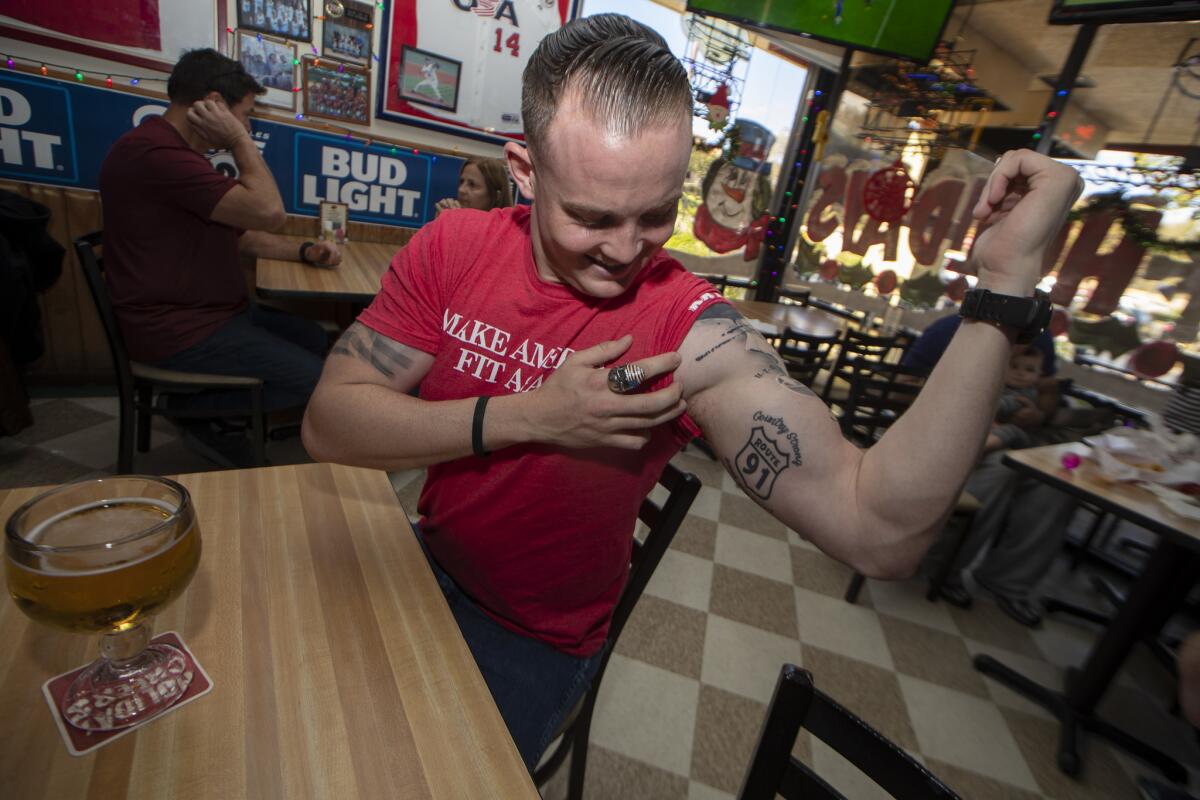
The photograph of the 11 friends was taken to capture the joy of hanging out at Borderline, of sharing beers and muddling through dance routines. Now it’s one of the last pictures of Meek and Orfanos.
Kelly and Gratland survived, as did the other seven friends in the photograph. A bullet skimmed the back of one of the men. Another friend escaped through a window shattered with a chair. One wedged himself near the end of the bar counter for hours, protecting a woman who hid under his legs.
The bar counter
Steve Campbell, 32, did not flee from the bar, instead wedging himself into a small space near the edge of the bar counter. A young woman took cover beneath his legs.
The two shielded themselves from view with a serving tray while smoke bombs provided extra cover. The two heard a rapid sequence of gunshots and then a lot of silence.
The attic
Trying their best to stay quiet, seven people sought refuge in the bar’s attic, which was filled with fiberglass and air conditioning units.
Bartender Bobby Langin Jr. and the bar manager lay down next to the opening, at one point holding hands. Langin armed himself with a piece of plywood and watched the shadows through the door, fearful that every shot that went off was Long finding someone who had hidden and killing them.
The bar counter
Steve Campbell, 32, did not flee from the bar, instead wedging himself into a small space near the edge of the bar counter. A young woman took cover beneath his legs.
The two shielded themselves from view with a serving tray while smoke bombs provided extra cover. The two heard a rapid sequence of gunshots and then a lot of silence.
Kelly and Gratland survived, as did the other seven friends in the photograph. A bullet skimmed the back of one of the men. Another friend escaped through a window shattered with a chair. One wedged himself near the end of the bar counter for hours, protecting a woman who hid under his legs.
In the weeks since the shooting, the friends find themselves pulling up the photo on their phones, an image from what had seemed a safe haven. They gaze at the smiling faces of the friends who were lost.
Police are still investigating the massacre. They do not yet understand why Long targeted Borderline, a bar in his hometown. A place popular with veterans and young people, like himself. But the close bonds among Borderline regulars and staff undoubtedly altered the outcome of the tragedy.
Among those who survived was a bartender who guarded the attic door, ready to pounce on the shooter to save others hiding there. In the unlocked employee bathroom, three people leaned against the door to keep it shut.
The attic
Trying their best to stay quiet, seven people sought refuge in the bar’s attic, which was filled with fiberglass and air conditioning units.
Bartender Bobby Langin Jr. and the bar manager laid down next to the opening, at one point holding hands. Langin armed himself with a piece of plywood and watched the shadows through the door, fearful that every shot that went off was Long finding someone who had hidden and killing them.
When gunfire erupted, eight off-duty cops enjoying a night out protected customers by standing between them and the shooter and later carried people out. Other employees led patrons to hidden exits; most people believed the bar had only one way in and out.
These actions collectively seem to have derailed Long’s rampage. After the exchange of gunfire with the officers, Long did not target any more victims. He had brought magazines containing 210 rounds but fired no more than 60, police said.
Though the shooting has rattled Thousand Oaks, there is one thing survivors and their families return to as they remember the strangers who grabbed their hands and dragged them to safety, the people who smashed windows so they could escape, the friends who jumped in front of them as bullets flew: It could have been much worse.
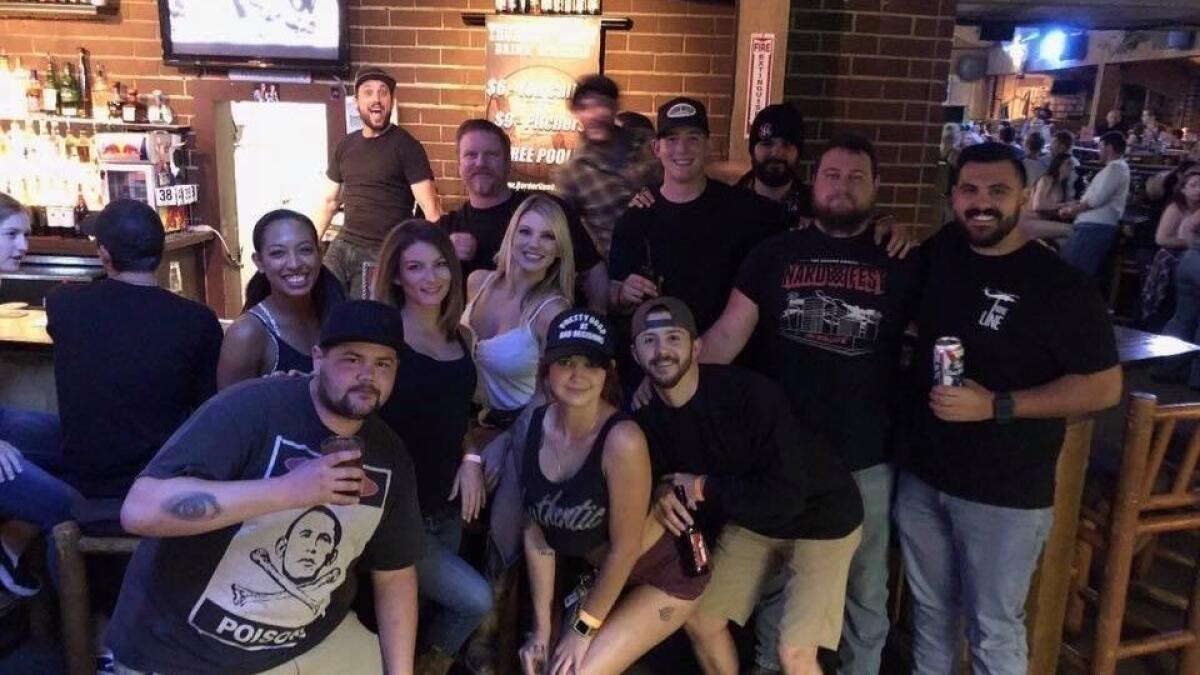
Production and graphics by Swetha Kannan.
For more California news, follow @brittny_mejia and @skarlamangla
Start your day right
Sign up for Essential California for news, features and recommendations from the L.A. Times and beyond in your inbox six days a week.
You may occasionally receive promotional content from the Los Angeles Times.





